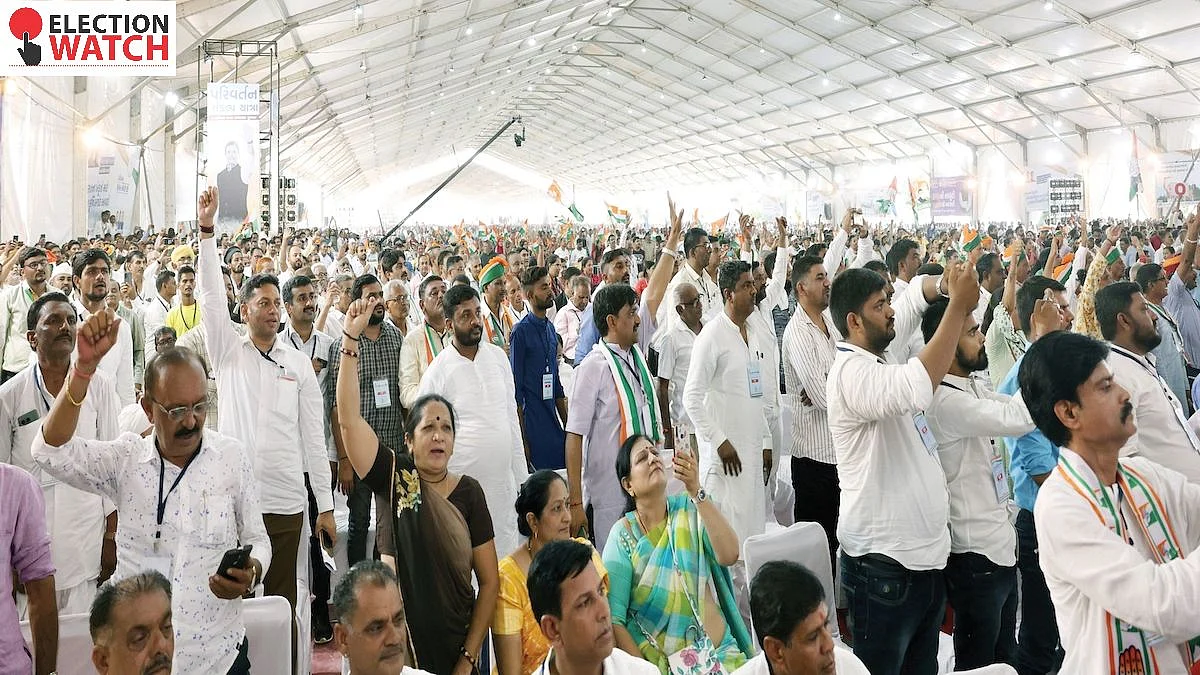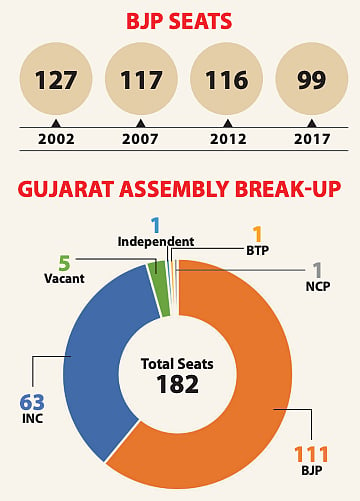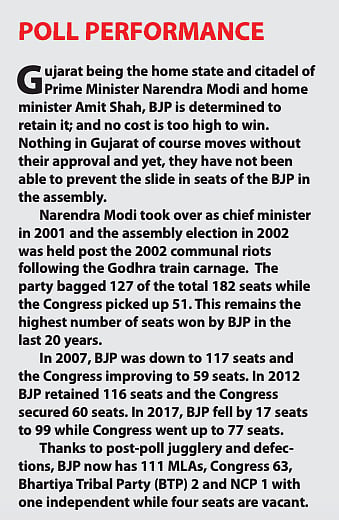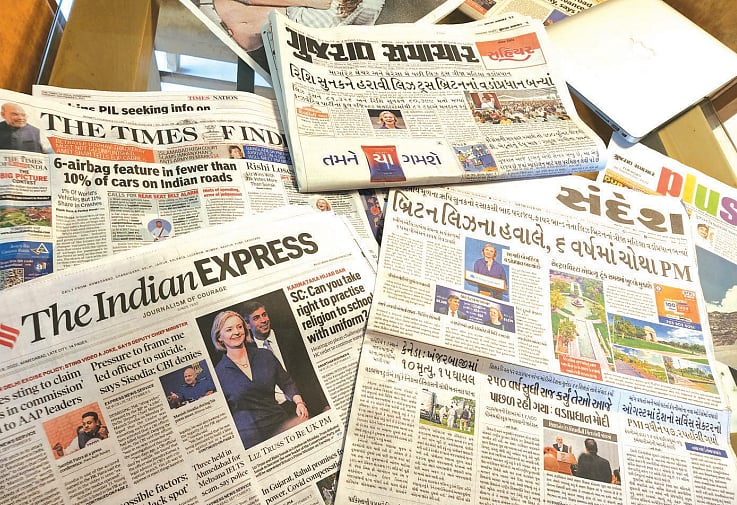Litmus test for opposition unity in Gujarat ahead of the assembly election
Votes secured by Congress and AAP in Gandhinagar municipal election was more than BJP’s votes, but Congress won two seats while AAP managed to win just one, with BJP bagging 41 of the 44 seats

Symbols are visible signs of invisible realities’ is an old saying. Prime Minister Narendra Modi’s two-day visit to Gujarat beginning August 27 as usual hogged front-page headlines. But the day after Congress leader Rahul Gandhi addressed 50,000 booth-level workers, the newspapers dutifully blacked out the event from their front pages. Editor of a news portal sarcastically tweeted images of the front pages and wondered at the editorial judgment.
The Prime Minister of course likes inaugurating statues, pathways, sea planes, catamarans, upgradation of the Sabarmati riverfront etc. So, there were no surprises when he inaugurated a footbridge.
A prominent national daily carried on its front page the photograph of the Prime Minister manfully striding down the colourfully crested footbridge named after former prime minister Atal Bihari Vajpayee on the Sabarmati riverfront in Ahmedabad. Right next to the photograph was a five column, tell-tale story of a tribal woman’s 9-year struggle for her husband’s death certificate, an issue which is now before the Gujarat High Court.
Three days later the same newspaper carried another report informing people that the footbridge will be accessible to only those who pay Rs 30 and that the ticket will be valid for the next 30 minutes. Children and senior citizens would have to pay half the fee while people with disabilities may access it for free.
The Atal footbridge cost the taxpayers Rs 74 crore. The irony is that if you take an auto-rickshaw to cross any of the bridges across the river, it charges Rs 5 per passenger. So, you pay six times more to have the pleasure of walking across the footbridge. Tucked into the same page was news that cybercrime cases in the state were up by 235 per cent in the last five years with economic offences going up from 4.5 per lakh of population in 2020 to 5.7 in 2021.



This and record drug hauls sum up the state of the ‘model state’ where a Rajkot journalist is booked for a report that claimed that ouster of the Gujarat Chief Minister Bhupendra Patel was imminent. The speculative report was not entirely without basis. Two ministers had been abruptly divested of key portfolios and Bhupendra Patel himself was installed unexpectedly after showing the door to Vijay Rupani.
The dissatisfaction with the state government has been high. The cattle menace on city roads has been a major issue. It was highlighted yet again when former deputy chief minister Nitin Patel landed in hospital after being hit by a stray cow in August. The High Court has been taking up the matter of stray cattle on roads for years and had warned of stern action in 2017. The state BJP president, CR Patil, had assured of necessary action. The Assembly on April 1 this year passed a bill seeking to regulate stray cattle in urban areas of the eight municipal corporations and 162 towns.
The ‘maldhari’ community or cattle rearers were however up in arms and threatened to ‘boycott’ the BJP in the impending assembly elections. Barely a week after the bill was passed, on April 8, its implementation was put on hold. It was only after a tongue lashing from the High Court on August 30 that the Ahmedabad civic body was forced to act. It surprised nobody in the state, long used to policies and decisions tailored for elections.
As Gujarat moves into the pre-poll phase of the assembly elections due in December this year, a triangular contest appears a certainty with the Arvind Kejriwal-led Aam Admi Party (AAP) throwing its hat in the ring. Gujarat till now has been an electoral battleground between traditional rivals Congress and the BJP. Both will be wary about the high-voltage, high-publicity campaign launched by AAP.
Traditionally, regional outfits in Gujarat have not done well. From former chief minister and Congress leader Chimanbhai Patel’s Kisan Mazdoor Lok Paksha (KMLP) to BJP rebel Shankersinh Vaghela’s Rashtriya Janata Dal and veteran Gujarat BJP leader Keshubhai Patel’s Gujarat Parivartan Party, none has done well in elections. Can AAP reverse the trend?
Sources in the know maintain that Arvind Kejriwal’s original strategy was to utilise the assembly elections in Gujarat to build his party’s organisational structure in the state while actually concentrating on Himachal Pradesh which goes to the polls alongside Gujarat. Firmly in the saddle in Delhi and with the bonus of having bagged Punjab, he wanted Himachal in his kitty before concentrating on Haryana in order to build AAP’s presence in a contiguous land mass and emerge as an important player in the 2024 parliamentary sweepstakes.
However, AAP was forced into a strategic shift when Delhi health minister Satyendar Jain, who was overseeing the Himachal poll planning for the party, was arrested by the Enforcement Directorate.
The 'B' team of BJP or not, AAP could no longer avoid a direct and electoral confrontation with the saffron party which appeared to be going for its jugular after AAP’s Punjab victory. It therefore decided to beard the BJP in its own den—Gujarat—and Kejriwal arrived with all guns blazing.
The AAP was in part buoyed by the Surat municipal corporation results where it bagged 27 seats to the BJP’s 93 in a 120-member civic body. Congress was the loser. However, in the Gandhinagar Municipal Corporation elections, AAP won only one seat but managed to drag the Congress down to two seats. While BJP bagged 41 of the total 44 seats, reducing the Opposition to just three, the combined Congress-AAP vote share was higher than that of BJP's.
This is a warning sign that the two parties need to heed. Working together, the two parties possess the firepower to take on the BJP and Narendra Modi on his home ground. But divided and at loggerheads with each other, they will be picked up separately and strung out to dry.
The Congress for the most part, has been an ethical opponent, but AAP is not bogged down by any such considerations as it takes on Modi on his home turf. After CBI raids on Delhi deputy chief minister Manish Sisodia, AAP’s aggression in Gujarat has increased. While Rahul Gandhi has decided to bypass the poll-bound states of Gujarat and Himachal Pradesh in his Bharat Jodo Yatra in an effort to keep it non-partisan— neither Modi, who had embarked on the Gujarat Gaurav Yatra after the 2002 communal riots, nor Kejriwal is likely to stop at anything for electoral gains.
AAP is also using the Gujarat elections to build the national profile of Arvind Kejriwal as the potential challenger to Narendra Modi in 2024. This profiling has picked up speed ever since Bihar Chief Minister Nitish Kumar made strategic adjustments by doing a Maharashtra on Modi in Bihar.
Modi remains formidable and is a tough nut to crack in Gujarat but he and the BJP are far from invincible; provided the two main opponents taking him on in Gujarat join hands rather than look for a win in a triangular contest—which benefits only the BJP.
Follow us on: Facebook, Twitter, Google News, Instagram
Join our official telegram channel (@nationalherald) and stay updated with the latest headlines
